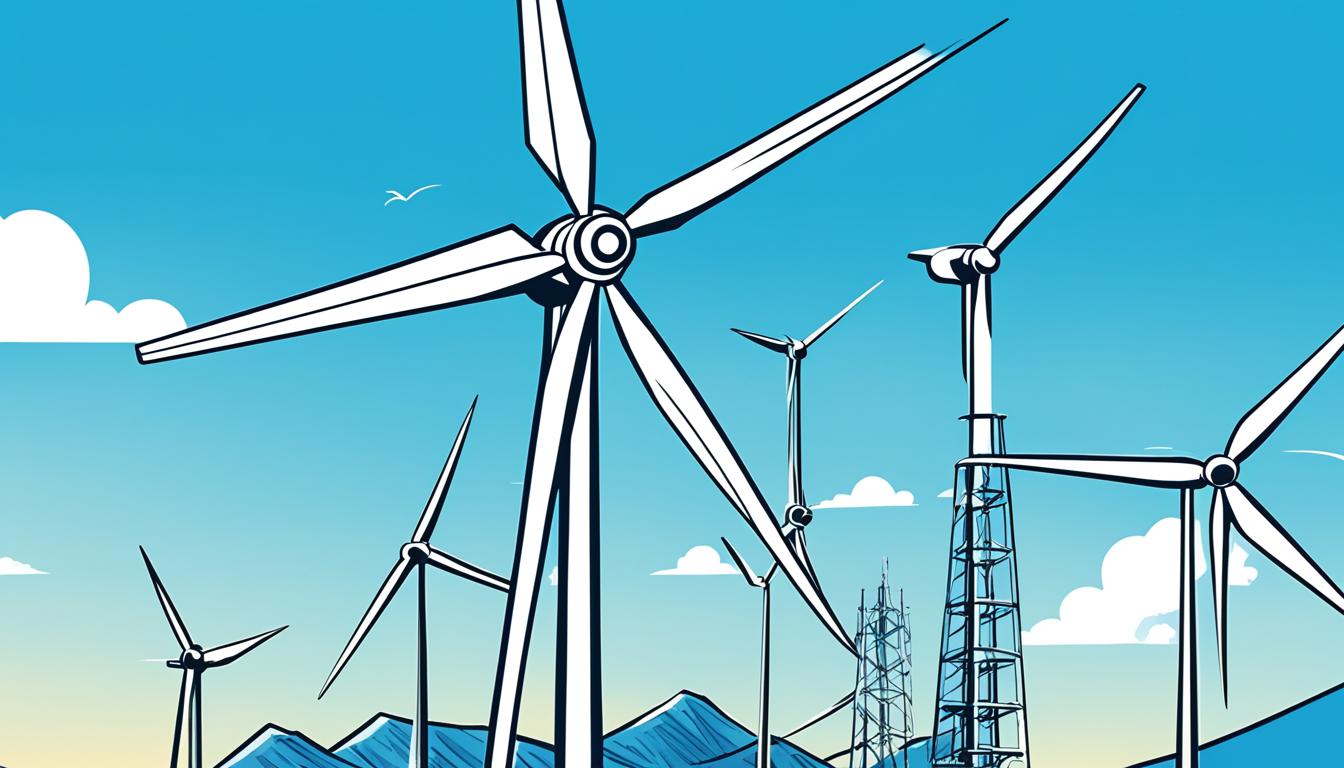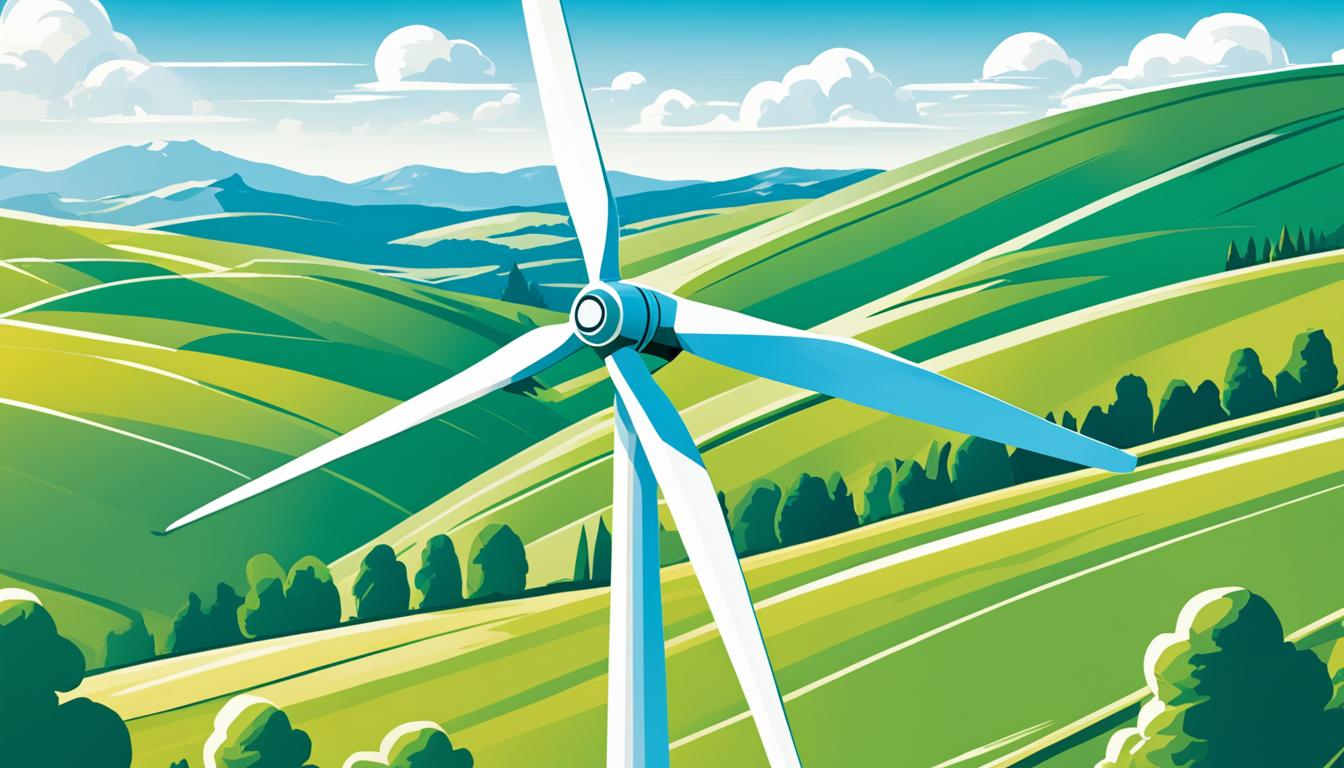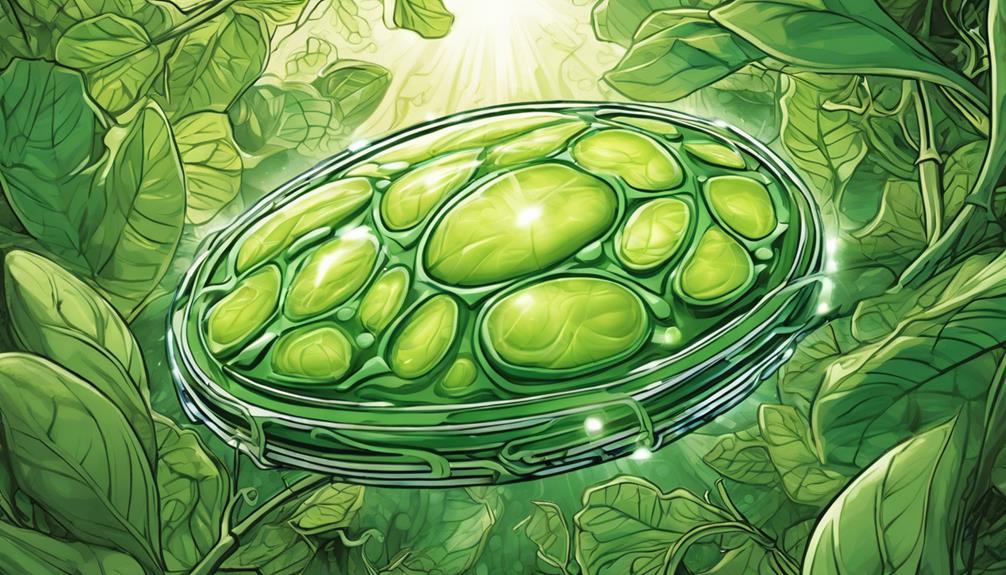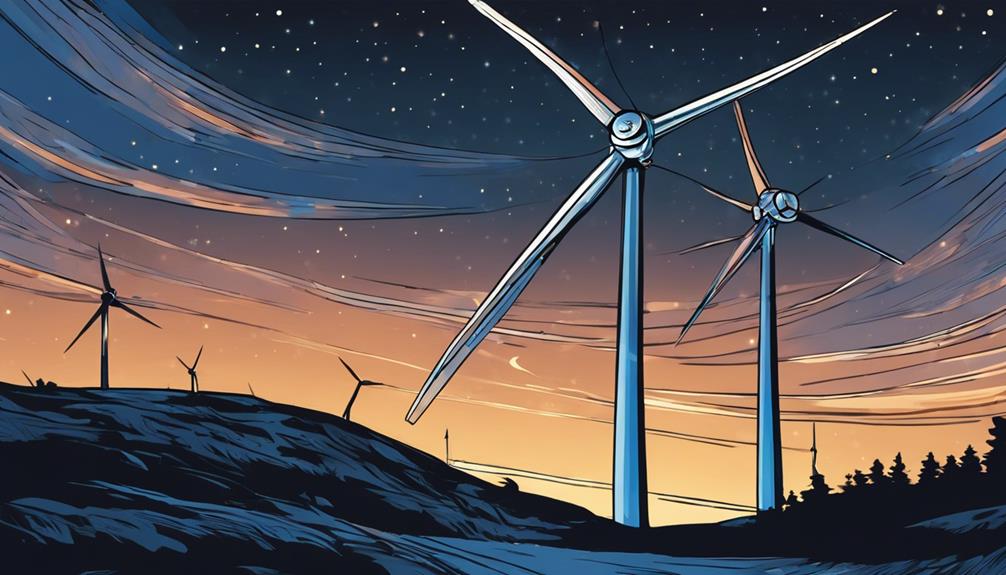Did you know that the ideal number of blades for wind turbines depends on various factors, including optimizing efficiency and performance? Wind turbines typically have three long blades, while windmills and water pump windmills might have more blades. Home fans, on the other hand, can have different blade counts. So, what is the optimal blade count for wind turbines? Let’s delve into this topic and explore the factors that influence the blade count.
The number of blades on a wind turbine plays a crucial role in its performance and efficiency. The German physicist Albert Betz showed that the fundamental laws of mass and energy conservation limit the capture of wind kinetic energy to 16/27 (59.3%), with modern turbine designs reaching 70-80% of this theoretical limit1. Wind turbines typically have a cut-in speed of around 3-4 m/s, cutting out at 25 m/s1.
Commercial wind turbines have a survival speed ranging from 40 m/s (144 km/h) to 72 m/s (259 km/h), with most surviving at around 60 m/s (216 km/h)1. Control systems in wind turbines consist of sensors, actuators, and control algorithms1.
The survival speed of some turbines can reach up to 80 m/s (290 km/h)1. Wind turbines with variable-pitching under 50 kW generally use systems operated by centrifugal force1. A report funded by the Atkinson Center for a Sustainable Future identified fundamental gaps in pitch control, limiting energy cost reduction1.
Pitch controllers ensure that the pitch angle of wind turbine blades remains within a specific range (0° to 30°) with a change rate of 10°/second1. Large wind turbines typically operate at variable speeds to capture as much power as possible; generator torque is used for control1. Wind turbines are actively controlled to face the wind direction, minimizing yaw angle for optimal power output1. The control strategy for wind turbines may involve maintaining the torque angle at 90 degrees for efficient power generation1.
Key Takeaways:
- The ideal number of blades for wind turbines is influenced by optimizing factors such as efficiency and performance.
- German physicist Albert Betz determined that the capture of wind kinetic energy is limited by fundamental laws, with modern turbine designs reaching up to 80% of this limit1.
- Wind turbines typically have a cut-in speed of around 3-4 m/s and cut out at 25 m/s1.
- Commercial wind turbines have varying survival speeds, with most surviving at around 60 m/s1.
- Control systems in wind turbines consist of sensors, actuators, and control algorithms1.
- Pitch controllers maintain the pitch angle of wind turbine blades within a specific range, ensuring optimal power generation1.
Factors Influencing Wind Turbine Performance
When it comes to wind turbine performance, several factors come into play, ranging from design parameters to environmental conditions. Understanding the key influencers is crucial for optimizing the efficiency and effectiveness of wind turbines.
Blade Count and Shape
The number of blades on a wind turbine is a critical design parameter that directly impacts its performance. Research on crossflow wind turbines has shown that different blade counts can yield varying results. For instance, an experimental investigation on 8, 16, and 20-blade turbines revealed that the best performance was achieved with 16 blades2. Similarly, previous studies on Banki wind turbines indicated that an 8-blade turbine achieved a maximum Capacity Factor (Cp) of 0.32. Wind turbine designers must carefully consider the optimal blade count for their specific application to ensure optimal power output. Moreover, the advantages of wind turbine gardens, which consist of multiple small wind turbines, have been linked to the use of a higher number of blades. Studies have suggested that wind turbine gardens with a greater blade count can capture more wind energy and produce more power compared to single larger turbines. Therefore, understanding the relationship between blade count and performance is crucial for maximizing the efficiency of wind energy systems, particularly in the context of wind turbine gardens.
Additionally, blade shape plays a crucial role in wind turbine performance. The aerodynamic design of the blades affects their ability to harness wind energy efficiently. Factors such as airfoil shape, chord length, and twist distribution can significantly impact power generation. By carefully designing the blade shape, engineers can optimize the performance of wind turbines.
Wind Speed and Environmental Conditions
Wind speed is another critical factor that influences wind turbine performance. Higher wind speeds result in increased kinetic energy, allowing turbines to generate more power. The relationship between wind speed and power output is nonlinear, with higher wind speeds exponentially increasing power generation. Therefore, locating wind turbines in areas with consistent and strong wind resources is essential for maximizing their performance.
Environmental conditions such as temperature, air density, and turbulence also impact wind turbine performance. Changes in air density due to temperature fluctuations can affect the rotor’s ability to capture wind energy, influencing power output. Turbulence caused by factors like nearby structures or terrain can also disrupt wind flow and reduce turbine efficiency.
Turbine Size and Design Parameters
Wind turbine size and various design parameters have a significant impact on performance. Factors such as blade length, tower height, and rotor diameter directly affect the power generation capacity of a turbine. Increasing the size of the turbine enhances its ability to harness wind energy, resulting in higher power output.
Moreover, the orientation and arrangement of wind turbines within a wind farm can affect performance due to wake effects. Proper spacing and alignment of turbines minimize the negative impact of wakes, optimizing power generation.
Summary
The performance of wind turbines is influenced by numerous factors, including blade count, blade shape, wind speed, turbine size, and environmental conditions. Design parameters such as blade length, tower height, and rotor diameter also play a crucial role. By considering and optimizing these factors, engineers can enhance wind turbine performance and contribute to a more sustainable and efficient energy future.
Blade Transport and Logistics
Transporting wind turbine blades is an intricate and costly process that requires careful planning and coordination. Due to the significant size and weight of the blades, specialized transportation methods are needed to ensure their safe delivery to wind farm sites.
Wind turbine blades can vary in length, with typical sizes ranging from approximately 116 feet to 200 feet3. They are usually made of fiberglass, which provides durability and strength3. The transportation of these long and heavy blades poses unique challenges for logistics operators and transportation companies.
The transportation process for wind turbine blades involves a combination of trucks, railcars, and ships. A single wind farm with a capacity of 150 megawatts can require up to 650 truckloads, 140 railcars, and eight ships to transport all the necessary wind components4. This highlights the sheer scale of the logistics involved in wind turbine transportation4. As the demand for clean energy continues to grow, the need for efficient and reliable transportation methods becomes even more crucial.
Transporting wind blades for wind farms typically requires careful planning and coordination due to their large size. The length of wind blades typically ranges between 53 meters and 62 meters, depending on their structural characteristics4. Supporting tower structures for wind turbines are also limited in diameter to ensure they can be transported effectively, typically ranging from 4.3 meters to 4.6 meters4.
The transportation of wind turbine components, including blades, towers, and nacelles, often begins approximately one year prior to the actual transport operation. This allows for sufficient time to plan routes, acquire permits, and coordinate with various stakeholders involved in the transportation process4.
Cost is another significant aspect of wind turbine blade transportation. The cost to transport a wind turbine fan blade from a port to a wind farm can range between $100,000 and $150,0005. As blades become longer and heavier, the associated costs are expected to rise, requiring transportation companies to allocate more resources for these specialized transports5.
Transportation Challenges and Solutions
Transporting wind turbine blades poses unique challenges due to their size and weight. Blades often fall into the superload category, requiring transportation companies to obtain permits and surveys for every state they pass through5. Additionally, there is a shortage of experienced drivers with expertise in handling superload equipment, further exacerbating the transportation difficulties5.
However, innovative transportation companies are emerging to provide solutions for wind turbine logistics nationwide. For instance, Titan Worldwide is one such company that specializes in transportation services for wind turbine components. Their expertise and specialized equipment help overcome the challenges associated with wind turbine blade transportation5.
In conclusion, the transport and logistics of wind turbine blades are complex and costly endeavors. The size and weight of the blades necessitate specialized transportation methods, careful planning, and coordination. As the wind energy industry continues to grow, finding efficient and reliable transportation solutions becomes paramount to support the development of clean energy sources.
Different Sizes of Wind Turbines
Wind turbines come in various sizes to cater to different energy requirements. Understanding the different sizes and their capabilities is crucial in maximizing wind energy capture and optimizing wind turbine blade configurations.
Smaller wind turbines, typically equipped with towers ranging from 120 to 215 feet in height, are suitable for household needs. These turbines have a lower electric-generating capacity, making them ideal for residential use6.
Medium-sized wind turbines, with towers ranging from 215 to 275 feet, are commonly used for community power generation. These turbines have a higher electric-generating capacity compared to smaller models, making them suitable for supplying energy to multiple households or small communities6.
For large-scale wind energy projects, larger turbines with towers measuring 280 feet or more are utilized, especially in offshore wind farms. These turbines have a significantly higher power generation capacity6.
| Turbine Size | Tower Height Range | Electric-Generating Capacity |
|---|---|---|
| Small | 120-215 feet | Up to 10 kilowatts |
| Medium | 215-275 feet | Varies (community power generation) |
| Large | 280 feet or more | Up to 15 megawatts |
When selecting an appropriate wind turbine size, factors such as energy requirements, available space, and budget considerations need to be taken into account. It’s essential to choose the right size to ensure effective energy capture and efficient wind turbine operation6.
Optimizing Wind Turbine Blade Design
The design of wind turbine blades plays a crucial role in maximizing energy capture and efficiency. Curved blades with a proper aerofoil shape are key to generating optimal lift and thrust, allowing for the efficient deceleration of wind and improved blade efficiency7. These aerodynamic features contribute to higher turbine performance and power generation.
Studies have shown that curved turbine blades can capture up to 5 to 10 percent more wind energy, making them operate more efficiently in areas with lower wind speeds78. By utilizing the curved shape, these blades are able to generate a lifting force perpendicular to the airflow, resulting in higher rotational speeds and better performance8. Additionally, the curved design enables them to operate at a wider range of wind speeds, improving overall energy capture efficiency.
In order to optimize wind turbine blade design, constant improvements are being made to enhance efficiency, noise reduction, and power generation capacity7. These advancements aim to make turbines more compact, quieter, and capable of generating more power from less wind7. For example, rotors with a twist along their length, ranging from 10 to 20 degrees from the root to the tip, can optimize the angle of attack, maximize lift, and improve rotation8. By incorporating these design elements, wind turbines can extract more energy from the wind, improving overall efficiency.
The number of blades is also a significant factor in wind turbine design. Research has shown that increasing the number of blades from one to three can lead to efficiency improvements, although with diminishing returns9. Going from one to two blades increases efficiency by 6%, while going from two to three blades only increases efficiency by 3%9. This finding supports the prevailing trend of using three blades in modern wind turbines, as it balances structural and economic considerations9. Fewer or more blades present challenges and increased costs, making three blades the preferred choice for most wind turbine designs9.
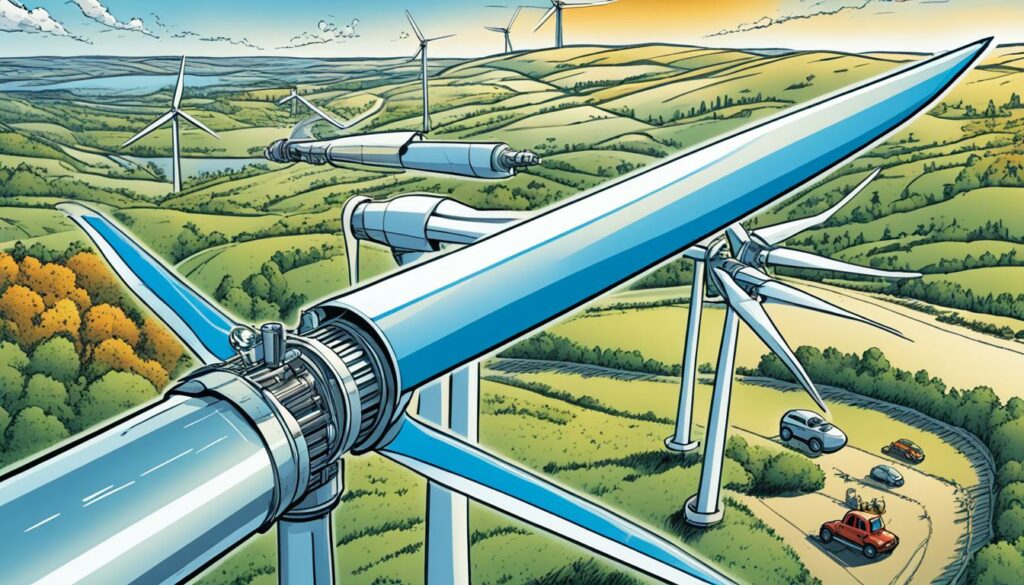
Online platforms like SimScale provide engineers with computational fluid dynamic (CFD) simulations to optimize wind turbine blade design7. These simulations can help identify the optimal tip speed ratio (TSR), which depends on the rotor blade shape profile, number of turbine blades, and design7. By leveraging CFD simulations, engineers can iteratively refine blade designs to improve performance, efficiency, and overall wind turbine operation.
| Design Element | Benefit |
|---|---|
| Curved Shape | Captures 5-10% more wind energy and operates efficiently in lower wind speeds78 |
| Aerofoil Profile | Generates lift and thrust for efficient deceleration and increased blade efficiency7 |
| Twisted Design | Optimizes angle of attack, maximizes lift, and improves overall rotation8 |
| Three Blades | Balances structural and economic considerations, providing optimal performance9 |
Computational Fluid Dynamics for Blade Optimization
Computational Fluid Dynamics (CFD) simulation plays a crucial role in optimizing wind turbine blade design, allowing engineers to analyze and improve the aerodynamic performance of the blades. By using CFD simulation tools like SimScale, engineers can accurately measure the flow around and downstream of wind turbines, surpassing the accuracy of field testing and semi-observational models10.
One of the significant advantages of using CFD simulation is the ability to evaluate the performance and efficiency of different blade shapes, sizes, and environmental factors. This enables engineers to test design iterations and find the most efficient blade design for maximum power output and overall wind turbine performance1011.
A downstream wind turbine in full-wake conditions can experience a power loss of 30-40% compared to upwind turbines, and fatigue loads can potentially be up to 80% higher, depending on the wind conditions and wind farm setup10. By analyzing the data obtained from CFD simulations, engineers can optimize rotor placements and shapes to enhance the overall power output of wind turbine systems, such as a 30 kW counter-rotating wind turbine10.
It is worth noting that different computational models used in CFD simulations, such as actuator lines and actuator discs, provide varying levels of accuracy in predicting turbine blade qualities and characteristics10. These models are continuously being refined and validated to ensure their reliability in optimizing wind turbine blade design and performance10.
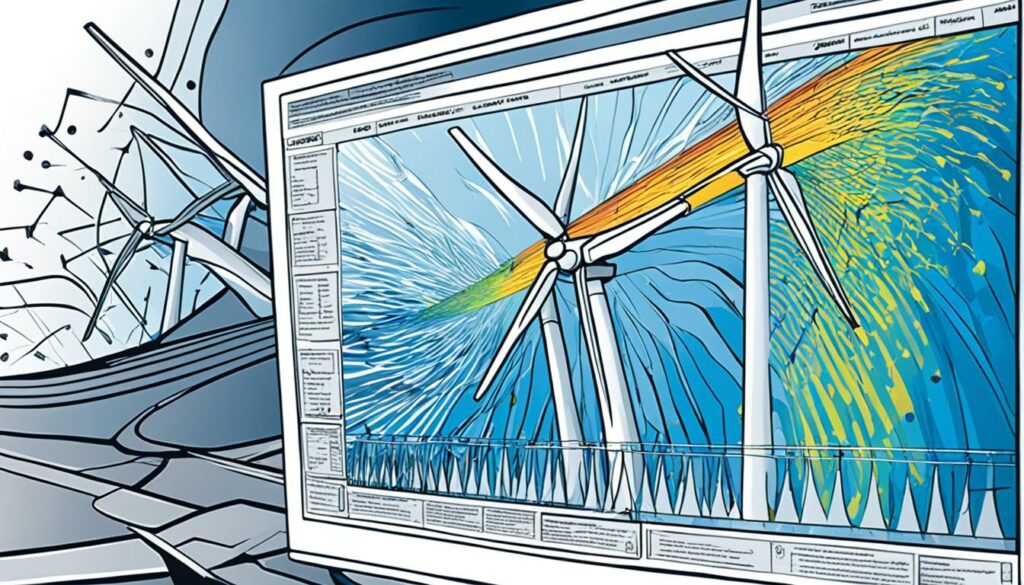
Advancements in Wind Turbine Blade Optimization
CFD simulation has revolutionized wind turbine blade optimization by allowing engineers to analyze and evaluate various factors that influence blade performance. Through CFD simulation, engineers can optimize wind blade design by integrating aerodynamic improvements, shape optimization, and topology optimization11.
With global wind power capacity reaching 837 GW in 2022 and a projected annual growth rate of around 9%, designing wind turbine blades for maximum power output at a minimum cost has become crucial11. Advanced materials and geometric optimization techniques are being employed to reduce wind turbine manufacturing costs while maintaining blade performance and efficiency11.
Shape optimization plays a vital role in enhancing wind turbine blade performance. By utilizing techniques like sensitivity analysis, Navier Stokes equations, and Lagrangian calculations, engineers can identify optimal blade shapes that maximize torque generation without significantly altering the blade’s overall length1112. The optimization process often involves multiple cycles to achieve incremental improvements over successive iterations11.
Research and Development in Blade Optimization
Research studies on blade optimization have explored various aspects, including the influence of winglet pitching, measurement of aerodynamic noise, wind tunnel testing of different tip shapes, and aeroelasticity to enhance blade performance12. For example, studies have investigated the effect of using winglets to enhance the performance of swept blades, as well as the impact of winglet planform and airfoil on the performance of horizontal-axis wind turbines12.
Furthermore, research has focused on the effectiveness of blade tips on low-speed horizontal-axis wind turbine performance and the reduction of tip-vortex noise using winglets12. These studies contribute valuable insights into blade optimization, providing engineers with the knowledge required to improve wind turbine performance and efficiency12.
| Research | Description |
|---|---|
| Elfarra et al. (2014) | Analyzed the influence of winglet pitching on a model wind turbine, focusing on aerodynamic loads, rotating speed, and wake statistics12 |
| Andersen et al. (2001) | Conducted research on the measurement and calculation of aerodynamic noise and optimization of vingetips on wind turbines12 |
| Barlas et al. (2021a) | Included wind tunnel testing of a swept tip shape and compared it with multi-fidelity aerodynamic simulations12 |
| Hansen (2017) | Presented a thesis on the aerodynamic optimization of airfoils and winglets for wind turbine applications12 |
| Farhan et al. (2019) | Performed a numerical study on the effect of winglet planform and airfoil on horizontal-axis wind turbine performance12 |
| Bak et al. (2007) | Focused on research in aeroelasticity, providing valuable insights into blade optimization and performance enhancement12 |
| Khalafallah et al. (2019) | Investigated the effect of using winglets to enhance the performance of swept blades of a horizontal-axis wind turbine12 |
| Khaled et al. (2019) | Analyzed the performance of small horizontal-axis wind turbines with and without winglets12 |
| Ariffudin et al. (2016) | Researched the effectiveness of blade tip on low-speed horizontal-axis wind turbine performance12 |
| Dhert et al. (2017) | Conducted research on aerodynamic shape optimization of wind turbine blades using a Reynolds-Averaged Navier–Stokes model and an adjoint method12 |
| Ebrahimi and Mardani (2018) | Worked on tip-vortex noise reduction of a wind turbine using a winglet12 |
| Johansen and Sørensen (2008) | Delved into increased aerodynamic efficiency on wind turbine rotors using winglets12 |
Advantages and Disadvantages of Wind Turbines
Wind turbines offer numerous advantages in terms of cost-effectiveness, environmental sustainability, and energy generation. However, they also present certain challenges and drawbacks that need to be considered.
Advantages of Wind Turbines:
- Cost-Effectiveness: Wind energy has a low operating cost since there is no ongoing expense for fuel once the turbine is installed13.
- Clean Energy Generation: Wind power is considered clean as it does not emit greenhouse gases during electricity generation13.
- Space Saving: Wind turbines save space on the ground, allowing for other land uses such as farming13.
- Job Creation: The wind energy sector has created more than 100,000 jobs in the U.S., particularly in utility-scale wind plants across 41 states13.
- Efficiency: Wind turbines are efficient at converting even light breezes into electricity13.
Disadvantages of Wind Turbines:
- Wildlife Impact: Wind turbines pose a potential danger to wildlife, particularly birds and bats, due to collisions13.
- Noise Pollution: Wind turbines generate noise that can impact wildlife in proximity13.
- Location Constraints: Wind power is constrained by the availability of strong and steady winds, limiting its effective generation to specific areas13.
It is worth noting that wind turbine technology is continuously evolving to address these challenges and improve performance. For example, research projects are underway to develop more slender and flexible blades and utilize 3D printing technology for customizable tower bases, with companies like Keystone Power Systems and GE Renewables leading the way14. Additionally, advancements in blade design and rotation speed selection have allowed modern three-bladed wind turbines to achieve approximately 80% of the Betz limit, increasing their efficiency15.
Despite the challenges and drawbacks, the advantages of wind turbines make them a promising and sustainable source of clean energy for the future.
The Growing Popularity of Wind Turbine Transportation
The increasing demand for wind energy has led to a surge in wind turbine transportation, as countries around the world invest in renewable energy. In the United States alone, over 144,000 megawatts of wind capacity have been installed, making it the largest renewable energy source in the country16. With an additional 8,500 megawatts added in 2022, representing a $12 billion investment, the wind industry continues to grow rapidly16.
Transporting wind turbines, particularly the oversized blades, requires specialized trailers and meticulous logistics planning. Wind turbine blade transport trailers are designed to safely and efficiently transport these large and delicate components to wind farm construction sites across the country16. The cost of transportation varies based on the distance and the complexity of the logistics involved16.
One of the key factors contributing to the rising popularity of wind turbine transportation is the significant reduction in wind energy prices. Power contracts signed in recent years range from 1.5 to 4 cents per kilowatt-hour, making wind energy one of the most cost-effective sources of electricity16. This has further incentivized the installation of wind turbines and the need for their transportation16.
Wind energy has also become a major employer, with over 125,000 people working in the wind industry in the United States. This includes those involved in manufacturing, construction, and other related sectors16. As the industry continues to expand, it is expected that up to 600,000 jobs will be created within the wind industry by 205017.
Another driving force behind wind turbine transportation is the advancement in wind turbine technology. Turbines have become taller, with an average height of 321 feet for land-based turbines installed in 202217. The blades themselves span up to 429 feet in diameter, requiring careful planning and execution during transportation17. Additionally, wind turbines now have around 8,000 different components, highlighting the complexity of modern turbine technology. This complexity necessitates specialized services and expertise in the transportation of wind turbines16.
However, there are challenges that arise with wind turbine transportation. The transportation of wind turbine blades often requires permits and surveys due to their size and weight, as they are classified as superloads18. This can lead to time-consuming processes and delays for transportation companies18. Furthermore, there is a shortage of experienced truck drivers, particularly in handling superloads, posing a significant challenge for the wind turbine transportation industry18.
Despite these challenges, the transportation industry is adapting to meet the growing demand for wind turbines and their components. Companies like Titan Worldwide are offering specialized wind turbine logistics services, ensuring the safe and efficient transportation of wind turbines to their destination18. As the demand for wind energy continues to rise, wind turbine transportation will play a vital role in the expansion of the wind industry.
| Statistical Data | Source |
|---|---|
| Average rotor diameter of turbines installed in 2022: 432 feet (up 173% since 1998–1999) | Link 1 |
| Average nameplate capacity of utility-scale wind turbines installed in 2022: 3.2 megawatts, showing a 7% increase from the previous year | Link 1 |
| Over 144,000 megawatts of wind capacity installed in the United States, making it the largest renewable energy source in the country | Link 1 |
| Over 8,500 megawatts of new wind capacity added in the U.S. in 2022, representing a $12 billion investment | Link 1 |
| The average height of a land-based wind turbine installed in 2022 was 321 feet, with the propeller blades spanning 429 feet in diameter | Link 2 |
| Wind energy employs over 125,000 people in the United States as of 2022, with expectations of up to 600,000 jobs within the wind industry by 2050 | Link 2 |
| Wind energy prices have dropped by 74% since 2008, making it one of the cheapest energy sources in the country | Link 2 |
| Wind turbine blades often require permits and surveys due to being classified as superloads, prompting tedious and time-consuming processes for transportation companies | Link 3 |
| A shortage of experienced truck drivers, particularly in handling superloads, poses a significant challenge for wind turbine transportation | Link 3 |
| The transportation industry is adapting to meet the growing demand for wind turbines, with companies like Titan Worldwide offering specialized wind turbine logistics services | Link 3 |

Conclusion
Optimizing wind turbine blade design is crucial for maximizing energy capture and efficiency. Factors such as blade count, shape, and design parameters significantly influence wind turbine performance. Computational Fluid Dynamics (CFD) simulation serves as a valuable tool for optimizing blade design19. Wind turbines offer numerous advantages in renewable energy generation, but transportation and logistical challenges must be addressed to ensure their widespread adoption20. The continuous advancements in blade design and transportation strategies will further enhance the efficiency and effectiveness of wind turbines1920.
It is worth noting that commercial wind turbines have reached a peak efficiency of up to 48%, achieving approximately 75-80% of the Betz limit, which defines the maximum energy capture potential1921. Wind farms located inland, coastal, and offshore have unique workloads with averages of 23%, 28%, and 43%, respectively19. The integration of permanent magnet generators enables wind turbines to operate continuously, irrespective of wind conditions1920. Additionally, innovative designs like Lipps turbines have shown the potential to generate significantly more power per acre per year, with higher installation densities and reduced sound impact19.
While modern turbines can achieve impressive efficiency levels nearing the theoretical limit set by Betz’ law, further research is needed to enhance energy capture and reduce fatigue loads21. Proper maintenance and the use of high-quality turbine parts, such as fibreglass, carbon fibre, and wood rotor blades, slip rings, and lightning protection systems, are essential for efficient and reliable wind energy projects20. With major manufacturers like Vestas, GE, and Siemens Gamesa leading the industry, wind turbines continue to be at the forefront of renewable energy generation20.
Overall, optimizing wind turbine blade design, leveraging advanced simulation techniques, and addressing transportation and logistical challenges will contribute to the continued growth and success of wind power as a sustainable energy resource in the future.
